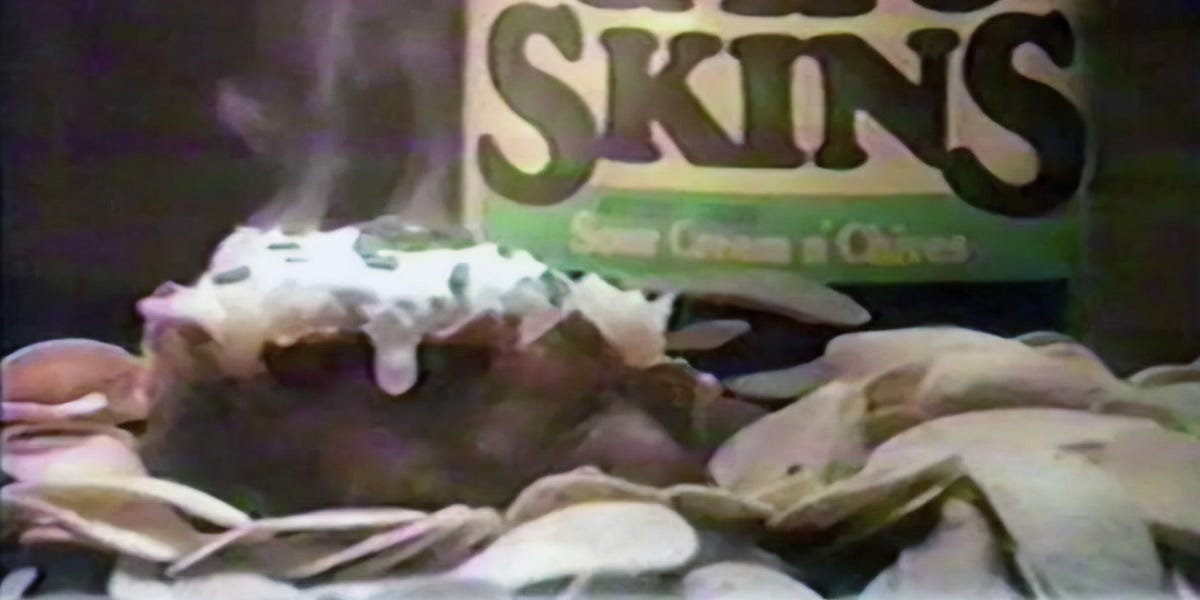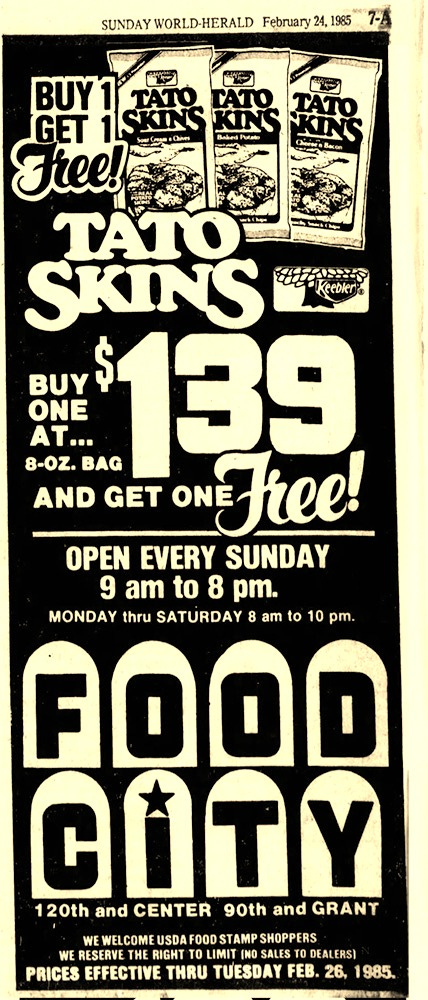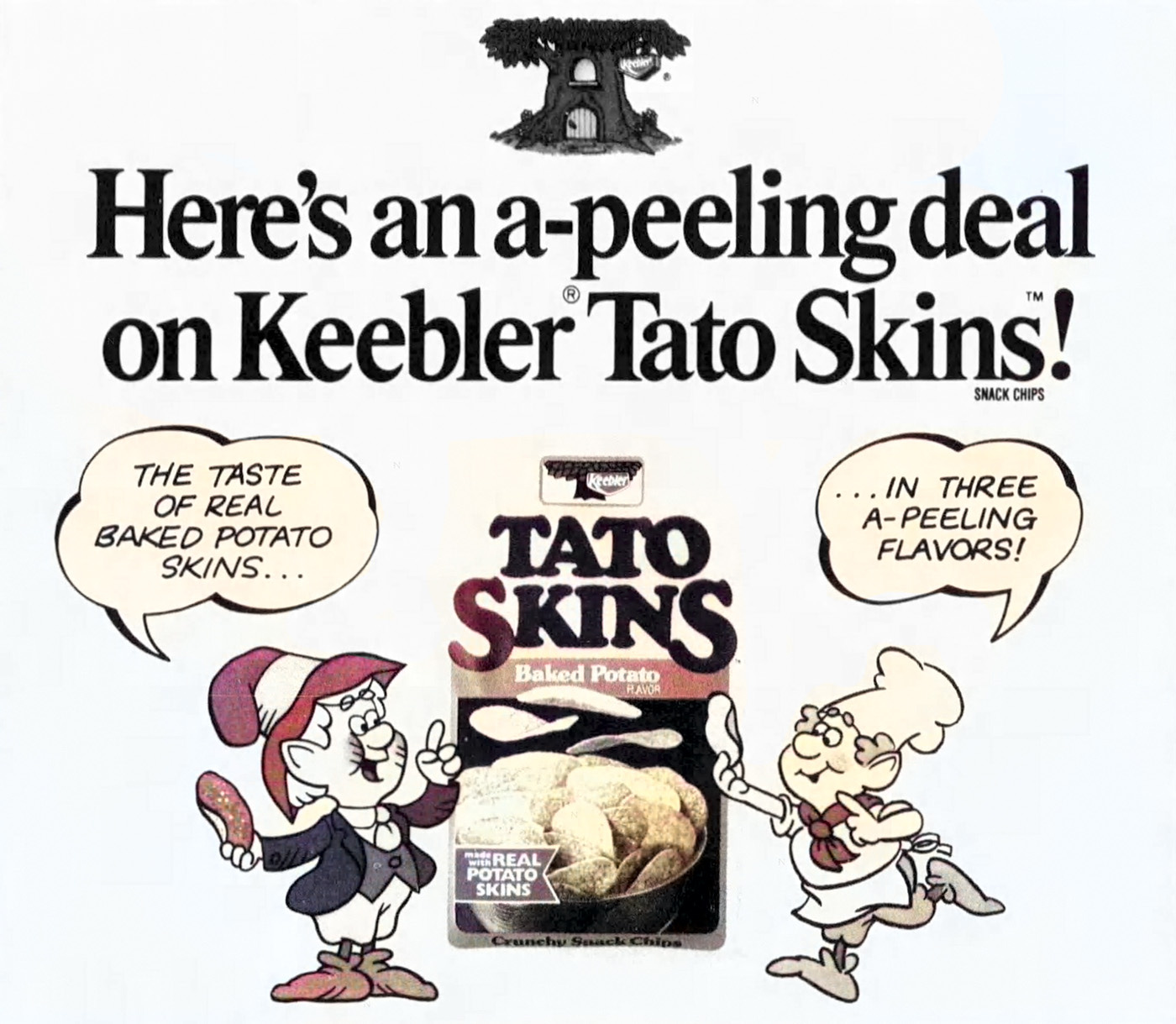
In March of 1985, my snack-eating habit changed forever when Keebler’s newest salty snack arrived in my supermarket in New Jersey. They were called Tato Skins and it was love at first sight. The appeal was instant. I already loved when my family ordered potato skins as an appetizer when we went out to eat. Chips were not all that common in our house, but luckily my mother liked novelty and we picked up a bag of the Cheddar Cheese n’ Bacon. My first bite when we got home was a taste experience. I was hooked by the crunchy crisp combined with the strong flavors. I knew right then I had found a new favorite snack food.
If you grew up in the eighties there is a good chance you remember Keebler Tato Skins. They were not just another potato chip, and technically they were not really a chip by most definitions. Made from potato, they were thick, two-toned, and shaped to look like tiny baked potato halves. One side was pale and soft-looking like the inside of a potato, and the other was darker, peel-like, and crisp.
That look was not an accident. Tato Skins were a carefully engineered snack, developed by Miles Willard and his company, Miles Willard Technologies, in Idaho. Willard was one of the most influential figures in shaping potato-based snacks in the late 20th century. He began his career at the USDA Eastern Regional Research Laboratory, where he contributed to advances in potato dehydration that later made fabricated snacks possible. In the 1970s and 1980s, after founding his own firm, he created snack products under contract for major companies.
Keebler hired Willard’s team for new potato-based products, and Tato Skins emerged in 1985 as one of the company’s most successful non-cookie launches. Willard’s expertise was in taking dehydrated potato material and transforming it into snacks that were crunchy, uniform, and visually distinctive. Tato Skins has all of those traits being designed to resemble the crisped edge of a baked potato skin while still being a manufactured product.
Among the many snacks attributed to Willard and his company are Hula Hoops in the U.K., O’Boisies, Ripplins, Chachos, CC Ricers, and of course Tato Skins. Each drew on his knowledge of how to make potato-based ingredients appealing in both texture and appearance.
I know some of you might be thinking, are these really chips? You are right. Tato Skins were better described as crisps than chips because of how they were produced. Traditional potato chips are cut directly from whole potatoes and fried, which gives them the irregular natural slices people expect. Tato Skins were made from a dough of dehydrated potato flakes, starch, and seasoning that was shaped and fried. This process allowed Keebler to control thickness, texture, and the two-tone look that resembled a real potato skin. Since they were fabricated rather than sliced, they fell into the same technical category as Pringles, which the FDA required to be labeled as potato crisps. Keebler marketed them as chips because that is what shoppers were looking for, but technically they were crisps, not classic potato chips.
Keebler was known for cookies at the time, but the salty snack market was hard to ignore. By 1984, the U.S. salty snack market was worth more than $6.1 billion in retail sales, and sales were growing by double digits. This was not their first step into that world. Since 1980 they had been making Butter Flavored Pretzels and Krunch Twists, but Tato Skins were something different.
They arrived at the right moment. While not a new food, America in the eighties loved baked potatoes loaded with toppings, and potato skins had become a staple appetizer in casual dining. TGI Fridays and Bennigan’s helped make them popular, and Wendy’s alone was slinging 600,000 a day. A baked potato split in half, scooped a little, and topped with cheese, bacon, and sour cream was everywhere. Keebler’s idea was to take that familiar appetizer and reimagine it as a portable snack.
Keebler’s pitch was simple, take the “baked potato appeal” and put it in a bag. Their commercials leaned into this message with the Keebler elves cheerfully explaining that the crisps were made “from potatoes and skins that are real.” The jingle hammered home that they were more authentic than regular potato chips.
Testing started in early 1985 and the first bags reached stores on February 24 of that year. By late March, they were available nationwide in 8 ounce bags. That was when I was lucky enough to see my first bag and try them myself.
The launch flavors were Cheddar Cheese n’ Bacon, Sour Cream n’ Chives, and Tasty Baked Potato. For me, Cheddar Cheese n’ Bacon was the star, a salty-sweet cheese powder amped up by artificial bacon flavor. Sour Cream n’ Chives had a cool tangy base with a mild herbal note. Tasty Baked Potato was more straightforward, aiming for the flavor of a simple savory potato. In 1988 Keebler added Barbecue, which did seem to be a major oversight as a flavor.
One thing that I always liked about the chips were how, because of their construction, very few of the chips in the bad would be broken. At least a lot less than what I got in a bag of chips. This was due to their construction not because of any special packaging.
The flavors were bold, but there was more to the experience than seasoning. Every Tato Skin had two sides. One stayed pale like the inside of a potato, the other browned to resemble the skin. That darker side carried a faint bitterness that made the flavor feel closer to an actual baked potato. It also created a visual hook that made the crisps instantly recognizable. Paired with a thick crunch you could not find in other chips, Tato Skins stood out.
Keebler ran plenty of promotions for Tato Skins. One of the most memorable was the Great Tato Skins Top-Off contest. Fans were invited to submit a topping or dip recipe in 150 words or less, along with proof of purchase seals. Entries were judged on originality, appetite appeal, and ease of preparation.
The prizes were generous. The grand prize included a 1988 Mercury Sable station wagon, a diamond pendant, and a Hawaiian vacation package. Other winners received Caribbean cruises, trips to Disneyland, and Oster kitchen appliances. It was a novel attempt to keep Tato Skins in the public eye. I only found one person who won that September who has made a baked dish with Tato Skins as a topping. Not sure they followed directions, but they got 4th place and an Oster kitchen appliance.
But the snack market moves fast. By the early nineties, kettle-cooked chips were gaining ground, baked snack lines were expanding, and extreme flavors were dominating the shelves. Tato Skins still had fans, but they were not the high-impact flavor bombs that new marketing demanded.
The big shift came around 2000 when Keebler no longer owned the brand. Poore Brothers, later known as Inventure Foods, bought the Indiana plant that produced Tato Skins and licensed the TGI Fridays name. The crisps returned to shelves as TGI Fridays Potato Skins Snack Chips, branded with the restaurant that had helped make potato skins famous in the first place. The flavors were familiar, but longtime fans noticed changes. The seasoning was lighter, the texture less rugged, and the Keebler elves were gone. Still, they survived, and you can find them even now under the TGI Fridays label, though they are more of a niche snack than the nationwide hit they once were.
This rebranding explains why many people thought Tato Skins disappeared in the nineties. In truth, they never fully vanished. They shifted into a restaurant-branded snack rather than one fronted by elves. That twist is fitting, since they were always meant to capture the flavor of a restaurant appetizer.
Even though the original Keebler bags are long gone, the memory of Tato Skins lives on for anyone who tried them in the eighties. They were a potent mix of food science, marketing, and timing. They turned a casual dining appetizer into something you could eat anywhere, and they stood out in a crowded aisle. The fact that they still exist in another form shows how strong the idea was, even if the Keebler elves are no longer on the bag. For those of us who first opened one decades ago, the crunch and flavor of Tato Skins remain a marker of a very specific snack moment in time.
Trending Products




![NOW Country Classics: 90âs Dance Party[Lemon & Spring Green 2 LP]](https://m.media-amazon.com/images/I/61hVquUofcL._SL500_._SS300_.jpg)





